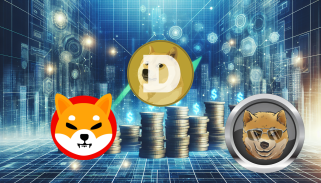
The Prolific Growth of Cryptocurrencies: An Exploration
In the realm of digital finance, the advent of cryptocurrencies has brought about a paradigm shift. Bitcoin, the pioneer cryptocurrency, emerged in 2009, promising a decentralized and autonomous monetary system. This alluring concept captivated the world and set in motion the proliferation of cryptocurrencies.
Cryptocurrency's Exponential Rise
Initially, Bitcoin faced skepticism. However, in 2013, its price surged beyond a few hundred dollars, igniting a crypto revolution. Since then, cryptocurrencies have multiplied globally, creating a vast and ever-evolving landscape.
Quantifying the Cryptocurrency Landscape
Estimating the exact number of cryptocurrencies is a challenging task, as the number fluctuates constantly. However, Statista estimates that by September 2024, the count will approach 10,000. Other sources suggest that the number may exceed 20,000, although many of these are inactive or discontinued.
CoinMarketCap, a leading data aggregator, lists 9,916 cryptocurrencies as of November 2023, while CoinGecko reports a count of 15,142. Determining the exact number remains elusive, but the substantial increase since 2009 is undeniable.
Genesis of the Cryptocurrency Abundance
The surge in cryptocurrencies can be attributed to the increased accessibility of blockchain technology. Platforms like Ethereum empower developers to create tokens without the need for complex blockchain development.
This low barrier to entry has resulted in an explosion of new projects, each boasting unique features such as faster transactions, privacy enhancements, or industry-specific applications. Some even cater to niche markets like gaming, art, and supply chain management.
Classification of Cryptocurrencies
The diverse cryptocurrency landscape comprises various types, each with its unique purpose:
- Bitcoin and Bitcoin Forks: Bitcoin, the progenitor of cryptocurrencies, serves as a decentralized, peer-to-peer digital currency. Forks like Bitcoin Cash (BCH) and Bitcoin SV (BSV) are iterations of Bitcoin with minor modifications for improved speed or transaction costs.
- Altcoins: This term encompasses all cryptocurrencies other than Bitcoin. Altcoins offer unique features, use cases, or technological advancements to disrupt the crypto ecosystem. Notable altcoins include Ethereum (ETH), widely recognized for its smart contract capabilities, and Solana (SOL), renowned for its speedy and cost-effective transactions.
- Stablecoins: Designed to mitigate volatility, stablecoins are pegged to stable assets like the US dollar. Tether (USDT) is the most popular stablecoin, providing stability for traders.
- Meme Coins: Created as playful projects, meme coins like Dogecoin (DOGE) and Shiba Inu (SHIB) have gained significant popularity due to viral social media presence.
- Utility Tokens: These tokens power specific applications. Chainlink enables the integration of real-world data into smart contracts, while Uniswap facilitates governance within the Uniswap decentralized exchange. Binance Coin, initially used for discounted fees on the Binance exchange, has expanded its utility across the Binance ecosystem.
Measuring Cryptocurrency Significance
Amidst the plethora of cryptocurrencies, only a select few have achieved widespread adoption, substantial market value, and technological impact. Bitcoin remains the dominant force, widely recognized as the foundational cryptocurrency.
Ethereum, with its smart contract capabilities and dApps, has played a pivotal role in the growth of DeFi (decentralized finance) and NFTs (non-fungible tokens). Other notable cryptocurrencies include Binance Coin, which powers the Binance ecosystem, and Solana, praised for its high-speed transactions.
While meme coins have gained attention, their long-term value remains uncertain. The cryptocurrency industry is highly dynamic, but few have truly revolutionized the landscape. Those that have continue to lead in innovation and market influence.


 crypto.ro English
crypto.ro English DogeHome
DogeHome Crypto News Land
Crypto News Land ETHNews
ETHNews CFN
CFN U_Today
U_Today Thecoinrepublic.com
Thecoinrepublic.com Optimisus
Optimisus






















